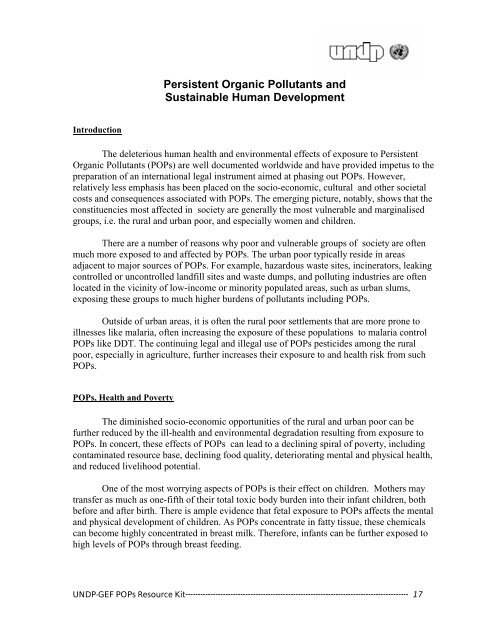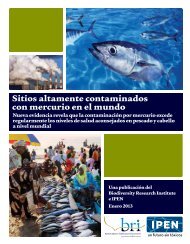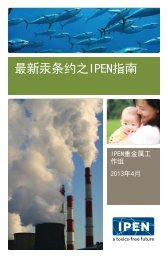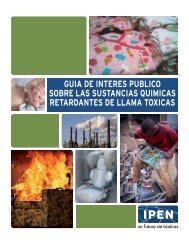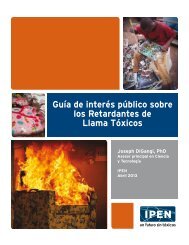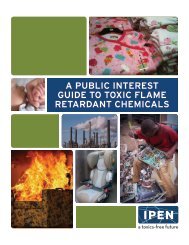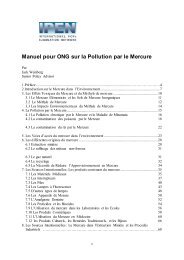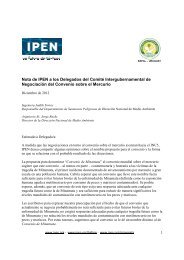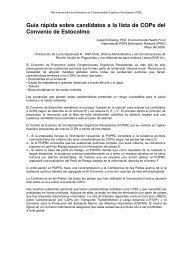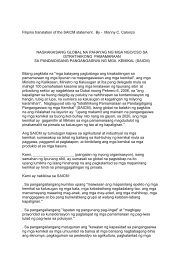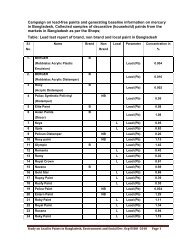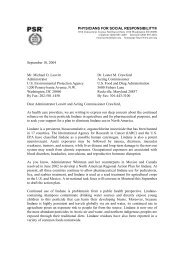The UNDP-GEF POPs Resource Kit - International POPs Elimination ...
The UNDP-GEF POPs Resource Kit - International POPs Elimination ...
The UNDP-GEF POPs Resource Kit - International POPs Elimination ...
Create successful ePaper yourself
Turn your PDF publications into a flip-book with our unique Google optimized e-Paper software.
Introduction<br />
Persistent Organic Pollutants and<br />
Sustainable Human Development<br />
<strong>The</strong> deleterious human health and environmental effects of exposure to Persistent<br />
Organic Pollutants (<strong>POPs</strong>) are well documented worldwide and have provided impetus to the<br />
preparation of an international legal instrument aimed at phasing out <strong>POPs</strong>. However,<br />
relatively less emphasis has been placed on the socio-economic, cultural and other societal<br />
costs and consequences associated with <strong>POPs</strong>. <strong>The</strong> emerging picture, notably, shows that the<br />
constituencies most affected in society are generally the most vulnerable and marginalised<br />
groups, i.e. the rural and urban poor, and especially women and children.<br />
<strong>The</strong>re are a number of reasons why poor and vulnerable groups of society are often<br />
much more exposed to and affected by <strong>POPs</strong>. <strong>The</strong> urban poor typically reside in areas<br />
adjacent to major sources of <strong>POPs</strong>. For example, hazardous waste sites, incinerators, leaking<br />
controlled or uncontrolled landfill sites and waste dumps, and polluting industries are often<br />
located in the vicinity of low-income or minority populated areas, such as urban slums,<br />
exposing these groups to much higher burdens of pollutants including <strong>POPs</strong>.<br />
Outside of urban areas, it is often the rural poor settlements that are more prone to<br />
illnesses like malaria, often increasing the exposure of these populations to malaria control<br />
<strong>POPs</strong> like DDT. <strong>The</strong> continuing legal and illegal use of <strong>POPs</strong> pesticides among the rural<br />
poor, especially in agriculture, further increases their exposure to and health risk from such<br />
<strong>POPs</strong>.<br />
<strong>POPs</strong>, Health and Poverty<br />
<strong>The</strong> diminished socio-economic opportunities of the rural and urban poor can be<br />
further reduced by the ill-health and environmental degradation resulting from exposure to<br />
<strong>POPs</strong>. In concert, these effects of <strong>POPs</strong> can lead to a declining spiral of poverty, including<br />
contaminated resource base, declining food quality, deteriorating mental and physical health,<br />
and reduced livelihood potential.<br />
One of the most worrying aspects of <strong>POPs</strong> is their effect on children. Mothers may<br />
transfer as much as one-fifth of their total toxic body burden into their infant children, both<br />
before and after birth. <strong>The</strong>re is ample evidence that fetal exposure to <strong>POPs</strong> affects the mental<br />
and physical development of children. As <strong>POPs</strong> concentrate in fatty tissue, these chemicals<br />
can become highly concentrated in breast milk. <strong>The</strong>refore, infants can be further exposed to<br />
high levels of <strong>POPs</strong> through breast feeding.<br />
<strong>UNDP</strong>-<strong>GEF</strong> <strong>POPs</strong> <strong>Resource</strong> <strong>Kit</strong>----------------------------------------------------------------------------------------- 17


